The
Naming of Beetle Rock at
Giant Forest, Sequoia National Park
How the Rock got a Name,
The World Discovered an Insect,
and
An Enthusiastic Amateur Entomologist Started a Career
by
John Lockhart, Education Coordinator
Sequoia Field Institute, Sequoia Natural
History Association,
HCR 89 Box 10, Three Rivers, CA 93271-9792
email:
john_lockhart@sequoiahistory.org
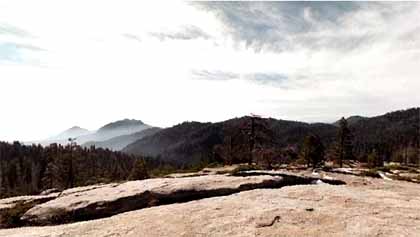 |
| View from Beetle Rock, Sequoia National Park |
The naming of Beetle Rock is only one of many inspirational stories that have happened there. Today, the Beetle Rock site is the location of an education center dedicated to enhancing understanding and appreciation of natural history. In 2001, with the restoration of the Giant Forest near completion, the education center moved into an old Park concession assembly hall built in 1940. First built with a stage and dance floor, the Beetle Rock building had served as a warehouse, ski shop, and dormitory. In 1941, ranger Douglass Hubbard met his wife-to-be, Fran, at Beetle Rock; three weeks later they were married: today, over 60 years later, they still are. Doug went on to be Chief Park Naturalist at Yosemite. Fran wrote children's nature books, among other things.[1] In the early 1940s, Sally Carrighar lived on Beetle Rock to research her first of many nature books, One Day on Beetle Rock, which tells the stories of various forest animals' lives and has become a classic in literature. In 1920, Sequoia National Park superintendent Walter Fry passed his leadership on to John White at a picnic on Beetle Rock.[2] Those two were arguably the most influential of all of Sequoia's superintendents.
It was in 1905 that Beetle Rock took its name because it was the site of the discovery of a species of insect then unknown to science: the beetle, Trachykele opulenta, discovered by amateur entomologist Ralph Hopping.
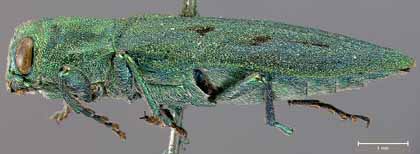 |
| The
Beetle of Beetle Rock: Trachykele
opulenta Fall, 1906[18], discovered
by amateur entomologist Ralph Hopping in 1905. (click to enlarge) Photo: Museum of Comparative Zoology, Harvard University. © President and Fellows of Harvard College |
I first became interested in verifying the story that Beetle Rock was so named when I read a passage from Sally Carrighar's 1973 book, Home to the Wilderness, her autobiography describing how she came to be a nature writer. This is the most recent reference to the naming of Beetle Rock.[3] She wrote:
The upper field of the Rock might be a sheet but cracks and clefts broke it up much as a beetle's back is divided - not the reason however why it was called Beetle Rock. An early-day entomologist had found a rare beetle on it, after which it became "beetle rock" to him and gradually was so called by others. I had tried, unsuccessfully, to find out what this beetle was so I could see if it still was there, but wildlife would not be scarce: that was plain from the first sweeping glance and hearing chirps and songs from the forest border.[4]
Next I found a 1921 guide book by Ansel Hall, an early Sequoia National Park Ranger, who went on to be chief naturalist of the National Park Service. In a section describing Beetle Rock, he wrote in his Guide to the Giant Forest, Sequoia National Park:
The Rock was named in 1905 when a new species of beetle was there discovered by Ralph Hopping, a Government entomologist.[5]
A letter written by Philip Wisner, an early historian of the Kaweah Common Wealth, to Frank Bean, an early Sequoia Park Naturalist, authored between 1933 and 1935, gives further credibility to the story. The letter was found in the Sequoia National Park's archive by Museum Technician Ward Eldredge,
Mr. Ralph Hopping (the son) was a most enthusiastic amateur entomologist and the forest, to him, was a happy hunting ground. To be on the spot [Giant Forest, Sequoia National Park] during the summer season (this was after the Colony [Kaweah Common Wealth] had been broken up) he with the permission of the park authorities and with the help of his wife conducted a camp for the entertainment of visitors. . . . Later Ralph was appointed as forest Ranger at Greely [Colorado, Canada? This would be out of chronological order with the known time line in 1905-1906 he was in the Giant Forest area[6]] - this gave him the opportunity of his heart's desire. He discovered a specimen of the bug species not then of record but which is now duly cataloged as is customary - with finder's name allied with that of the bug (I think that Ralph appreciates the honor more then the bug). Being thus himself "discovered" he was given a position in the U. S. Entomological Dep't and was located in San Francisco.[7]
See also p. 176, Co-Operative Dreams, by Jay O' Connell:
"Ralph was also an enthusiastic student of entomology, and later when serving as a ranger in General Grant Park, he discovered a species of theretofore unknown insect. This brought him great notice in the scientific world and launched his career as an entomologist."[8]
This reference and the letter above are a little at odds
with our story, in that they show various times and places for the
bug that made him famous. I do not believe either of the above authors
had consulted the entomological literature. As you will see below it
was only 1906 when Ralph had an insect named for him by one of America's
preeminent entomologist of the day. This is in the period when he
was working in Sequoia National Park.
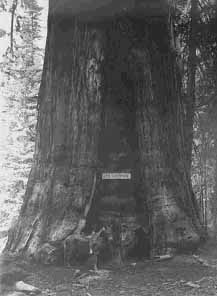 |
| Ralph
Hopping at Sherman Tree, 1905 George David Smith Photographic Collection |
Tracking a beetle
The
George Hopping family came from New York to the foothills of the
Sierra, present day Three Rivers,
California (elevation 1,200 ft.) to join the utopian Cooperative
Kaweah Colony[9] in 1881. In 1899, Ralph Hopping and
John Broder opened Camp Sierra and transported visitors to the Giant
Forest (elevation 6,000 ft.) in Sequoia National Park. They started
the first stage line into the Park, which traveled up the Old Colony
Mill Road. From
there, travelers would walk or ride horseback the last four miles
to Round Meadow in Giant Forest to stay at the camp.[10] It
was on these treks back and forth on the Old Colony Mill Road, and
at the camp at Round Meadow, a very short walk from Beetle Rock,
that Ralph
collected
many new species of insects.
Having independent references to the fact that Beetle Rock was named because Ralph Hopping found a new insect there, I wanted to find out which insect it was. The scientific community has a very exacting way of describing organisms. Entomologists use the Latin binomial name — genus and species — to designate an organism, as other biologists do. Entomologists take it one step further and almost always follow the binomial name by the author of the insect and sometimes the year the relevant article was published. The author is the person that wrote the academically published paper that describes the newly classified insect. Thus Pleocoma hoppingi Fall, 1906 is an organism, in this case an insect — a rain beetle — with the genus Pleocoma, the species hoppingi, described in an article published in 1906, and written by Fall (Henry Clinton Fall).[11]
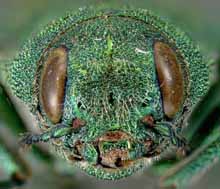 |
| T.
opulenta (click to enlarge) Photo: Museum of Comparative Zoology, Harvard University. © President and Fellows of Harvard College |
When I first started looking for the bug I naturally sought an insect authored by Hopping. I have contacted Cal Academy and others over the years looking for bugs discovered by Hopping. He was very prolific; Cal Academy, Berkeley has over 97,000 specimens collected by Hopping. He authored hundreds of insects in his long career. I contacted specialists but couldn't find an insect from the area that matched the right year and location.[12] Then it dawned on me that someone might have described it for him, as he didn't begin to author insects until later. This was borne out by a passage in his biography in The Pan-Pacific Entomologist pointing out that early in his career his friends described his finds "for instance Henry C. Fall."[13] I thought maybe someone named the insect after him; often a new insect will be named for the finder or someone that had become an authority on that group of insects. I searched for hoppingi; I discovered that in 1906 Fall named a rain beetle to honor Ralph Hopping, Pleocoma hoppingi.
Ward got the article, (Fall, H. C., 1906, A new Platycerus and a new Pleocoma: Entomological News, v. 17, 393-395), sent to him by Essig Museum of Entomology, which described P. hoppingi plus some other biographical and obituary references to R. Hopping and H. C. Fall. In the article Fall writes:
The following fine species of Platycerus and Pleocoma are somewhat recent discoveries of Mr. Ralph Hopping, of Kaweah, California.
I take pleasure in dedicating this fine species to friend Hopping, whose exploration in the Californian Sierras [sic] have brought to light not a few new and interesting species.
It was the above article that got me thinking that there might be yet other newly described insects collected by Hopping with a location that might better match Beetle Rock. At least now we were close to the right time period. The description of the two new bugs in the above article suggests that they don't live in areas as high in elevation as the Rock. Also they were collected in winter when Beetle Rock was probably inaccessible due to snow.
Success
at Harvard
A
search on Museum of Comparative Zoology (MCZ), Harvard's
type data base[14] for
label information returned
|
Original |
Trachykele opulenta Fall, 1906 |
|
|
Combination |
(Coleoptera: Buprestidae) |
|
|
Current name |
||
|
MCZ Type Number |
24436 |
|
|
Stage |
Adult |
|
|
Medium |
Mounted |
|
|
Label |
"6000 ft June 5; Kaweah Cal, Hopping" Type opulenta Fall; H. C. Fall Collection. |
|
|
Biogeographic region |
Nearctic |
|
|
Images |
none yet |
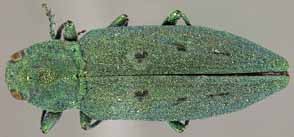 |
| T.
opulenta (click to enlarge). An original specimen collected
by Hopping ca. 1906. Photo: Museum of Comparative Zoology, Harvard University. © President and Fellows of Harvard College |
The actual insect associated with the above label was actually collected in the Giant Forest by Hopping and is preserved as a zoological record at Harvard.
The MCZ's Primary Type Specimen Database is a fantastic resource. (Very simply put, a "type specimen" is a collected insect that corresponds to the written article that describes the insect and is thus considered the standard for future research.) You can actually search by every field in the database. A search for "Hopping" in the "Label" field returned 9 species. They were dated from 1901 to 1931, with T. opulenta being the only one from 1906. The dates are the dates of authorship, not of collection. A search for Kaweah in the "Label" field returned 9 species, with 4 being the same as in the previous search. Again T. opulenta was the only one from 1906. However, there are other insects that Hopping discovered and gave to Fall, such as the earlier mentioned Pleocoma hoppingi Fall, 1906 and Platycerus opacus Fall, 1906 that are not found in either search of the "Label" field, as Fall failed to record either the year of collection or collector with the insect, although he does so in the describing article. The insects' data recorded with the preserved specimen are incomplete, Fall gives Hopping credit for collecting and finding them in the literature.[15]
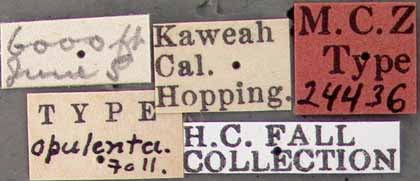 |
| Original
speciman labels for T. opulenta. Photo: Museum of Comparative Zoology, Harvard University. © President and Fellows of Harvard College |
I also searched all the California Beetle Bibliography,[16] a searchable data base with all the literature citations concerning Californian Beetles, for related articles. Fall published 17 articles from 1901 to 1907. It does not look like there are other likely insects that Hopping may have given Fall to describe.
Trachykele opulenta was described in the following article: Fall, H. C. 1906. On the genus Trachykele, with notes and descriptions of other North American Buprestidae: Entomological News, v. , 160-168. In the article Fall wrote "I have seen six examples of this beautiful species [T. opulenta], all but one of which were taken by Mr. Ralph Hopping in the Giant Forest region, Tulare Co."
It is possible that Hopping gave someone else new insects to describe and I have not been able to find them. There is the possibility that the bug he first discovered at Beetle Rock was collected in other areas when specimens for cataloging and describing were needed. That this is the one big find that rocketed him to entomological fame is dubious; in all likelihood, it is the totality of the amazing number of new insects he was able to present to Fall that gained him notoriety. What we do have is a documented relationship in which Ralph Hopping is giving H. C. Fall new species of insects to describe in the scientific literature between 1901 and 1932. We know that by 1906 Fall had named an insect after Hopping and recognized him in his literature. We know that Ralph was working in the area of Beetle Rock the summer of 1905 and was collecting insects before and after 1905. Fall’s type insects are stored at MCZ, Harvard with a searchable data base that reports many of the insects collected by Hopping and their location. Only one insect, Trachykele opulenta Fall, 1906, fits the time period and location corresponding to written references about the naming of Beetle Rock.
A world expert on the Buperstidae (the family of insect in which the Trachykele reside), Dr. C. L. Bellamy, wrote, “I have never collected it [T. opulenta], though would love to, but understand that it breeds in scars of giant sequoia and apparently incense cedar too.” He feels that this is probably the bug in question due to the preponderance of evidence.
Appendix:
1. Biography
R. Hopping
2. Further
resources of information on Hopping
3. In
response to a request for information
4. Photos
of Ralph Hoping
5. Additional
Photos of T. opulenta
References
[1] Letter, Douglass Hubbard to John Lockhart, November 7, 2001.
[2] Sequoia National Park Photographic Collection, Negative 5136, Picnic for Judge Fry and Col. White, Lindley Eddy photographer, July 27, 1920.
[3] Beetle Rock is not mentioned in the standard place name resource, Place Names of the Sierra Nevada: From Abbot to Zumwalt, Peter Browning, Wilderness Press, Berkeley, 1986
[4]Sally Carrighar, Home to the Wilderness, Houghton Mifflin Company, Boston, 1973, pp. 289.
[5] Ansel F Hall, Guide to Giant Forest, Sequoia National Park, A Handbook of the Northern Section of Sequoia National Park and the Adjacent Sierra Nevada, Published by the author, Yosemite, 1921 pp. 47.
[6] See Appendix: Biography Ralph Hopping
[7] Letter, Philip Winser to Frank Bean, 1933 - 35, Sequoia and Kings Canyon National Parks' archive, MAN B Box 1, folder 10, Cat #10276.
[8] Jay O' Connell, Co-Operative Dreams, A History of the Kaweah Colony, Raven River Press, Van Nuys, CA, p. 176,
[9] For more information on the Kaweah Colony see previous and William C. Tweed, Kaweah Remembered, the story of the Kaweah Colony and the Founding of Sequoia National Park. Sequoia Natural History Association, Three Rivers, 1986.
[10] Larry M. Dilsaver and William C. Tweed, Challenge of the Big Trees, Sequoia Natural History Association, Three Rivers, CA, 1990 pp. 89-90.
[11] H. C. Fall assembled one of the largest and best identified North American beetle collections of the early part of the twentieth century, and also described about 1,400 new species. His collection, kept in separate color-coded unit trays adjacent to material in the general collection, is of particular value for identification purposes. From Museum of Comparative Zoology at Harvard University http://www.mcz.harvard.edu/Departments/Entomology/hist_coll.cfm
[12] See appendix - letters
[13]Pan Pacific Entomologist, January 1942, v. XVIII, No.1, 1-3.
[14] Search for Trachykele opulenta, Museum of Comparative Zoology, Primary Type Specimen Database,
http://mcz-28168.oeb.harvard.edu/mcztypedb.htm.
[15] H. C. Fall, 1906, pp. 393-395.
[16] California Beetle Bibliography, California Beetle Project, Coordinator: Michael Caterino, Ph.D., Curator, Santa Barbara Museum of Natural History, http://www.sbnature.org/collections/invert/entom/cbphomepage.htm.
[17] Email, Dr C. L. Bellamy to John Lockhart, April 8, 2003, Plant Pest Diagnostics Laboratory,
email: cbellamy@cdfa.ca.gov http://www.cdfa.ca.gov/phpps/ppd/Entomology/
Coleoptera/Buprestidae/index.html
Co-Curator California State Collection of Arthropods, President (2003-2004) Coleopterists Society, Coleoptera Subject Editor: Zootaxa.
[18]Email 2, Dr C. L. Bellamy to John Lockhart, April 8, 2003, "I've attached a quickly captured image of a museum specimen of Trachykele opulenta."
[19] Sequoia National Park Photographic Collection.
Our Founder Questions? Go to About Our New Site |
Masthead
Photo from: |